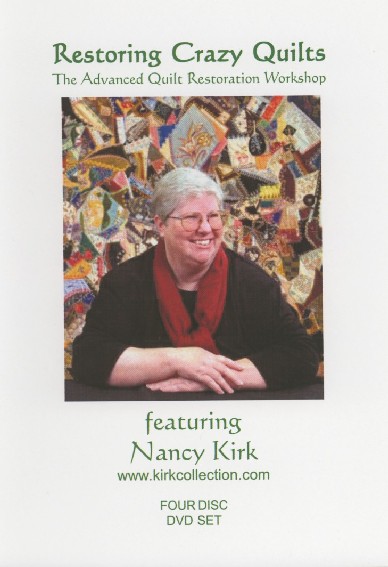
Crazy quilts are indeed the focus of this
workshop, but other aspects of restoring and being a professional restorer are
also included. One entire disk is dedicated to 10 quilts, 8 of which are in the
crazy style, made with silks or with wools. This disk gives the viewer a lot of
food for thought, which is the most important first step for a restorer.
Options and decisions are discussed for each of these quilts. Social history
that relates to an aspect of a crazy quilt or it's fabrics is also shared by
Nancy from time to time on this disk.
This workshop does not discuss sewing techniques in specific, but methods of
repairing split or disintegrated silks and embroidered stitches around them,
are verbally described in some detail. I learned some new ideas and new ways to
use cigarette silks. Chances are the original makers used some of these same
tricks, which Nancy has discovered by working on so many different types of
problems and quilts over the years.
The use of fusibles was discussed at some length, the problems they cause, and
the rare occasions in which they might be used. Typical adhesive fusibles,
which we can buy in quilt shops, are definitely not to be used on crazy quilts.
When having to use it, thin archival fusible is the only kind to use. The value
of the quilt decreases dramatically on the antique market if a fusible or any
adhesive has been applied. There is a decrease in a quilt's price value when
any restoration work is applied, Nancy tells us. If you plan to sell your quilt
to an antique dealer or collector, or donate it to a museum, it's best to leave
it as is. This is especially true when the quilt has historical value, in that
case, even washing it can decrease it's value. Nancy urges an owner to have a
consultation with a restorer before doing anything at all when the owner has
plans like these for its future.
Nancy says there is a high demand for quilt restorationist, but taking her
class or watching this video certainly doesn't make one a professional. That
title is earned with experience and practice. She spends time talking about
estimating, integrity and ethics, interviewing the client, and how important it
is to be sensitive to a client who loves her raggedy quilt.
I found this news flash very interesting and important to know. Nancy said that
the common practice of weighting silks, sometimes up to three times their
weight, ended in the 1950s. However, it is happening again in silks coming to
us from China. Watch out she warns, or you will be replacing one shattered
scrap with another that will also shatter.
This information will also be of interest to art quilters who use silk. The
bolts do not say the silk is weighted, but maybe if it says made in china, it
would be best to buy another type. She did not indicate there was any way to
tell for certain if a silk on a bolt is weighted or not.
There was some overlap with the basic course, and then she goes into a little
more depth on a topic, such as the use of crepeline, how to reconfigure badly
worn quilts, and a few of other general topics of interest to all quilt
restorers. This four disk DVD set was made one year after the first, in 2004.
The quality of the tape and sound, and ease of navigation is much improved. It
seemed to go faster because of it and both helped me use the remote control
much less often.
New to this workshop was a discussion of framing quilt fragments and how to
hang an entire crazy quilt.
I really enjoyed a segment shot at the International Quilt Study Center, on the
campus of the University of Nebraska, at Lincoln, which is about a thirty
minute drive west of Omaha, where Nancy's studio is. Here, we didn't really see
quilts, but we learned all about how the Center began, about the James, who
originally donated 900 quilts from their collection in exchange for an
agreement that the University would store them and share them for education and
benefit to quilt study. They have also more quilts since then and of course
money to support the Center, which is going to be breaking ground for a big new
facility in the near future. What a place that will be! Today, the Center has
nearly 1,700 quilts in their care, making it the largest collection of quilts
in one facility. The interviews with the collections manager and a volunteer
docent take place in the storage area of the Center, and they do show the
viewer around a bit. It's rather tight quarters, but they can get a lot of
quilts and people into the space. I had the opportunity to be there, and it did
not feel cramped whatsoever.
As in the basic DVD course, I got the distinct impression that taking the
course in person is far more helpful than the summary parts in the DVD, but if
you are just needing some information and ideas, than this DVD is helpful
indeed. To order this DVD or the basic, go to Nancy's website www.quiltcare.com
See also:
A review of the DVD
set
QUILT RESTORATION WORKSHOP
or
Crazy Quilting History: A Victorian Craze
by Judy Anne Johnson Breneman
Book publishers and authors: if you would like your book
reviewed on this Website, and it falls within the scope of topics, please
contact me.
|